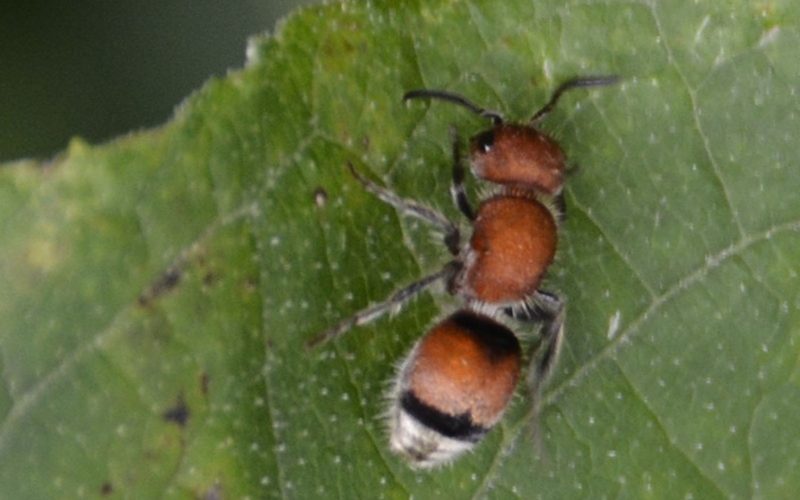‘Velvet ants’ beautiful to see, painful to meet
Making Ripples
Amanda Bancroft
Photo courtesy Amanda Bancroft
The common name “velvet ant” actually refers to more than 3,000 species of wasps, whose wingless females resemble giant, furry ants — and are actually kind of cute.
It’s a wonderful thing to discover something new and astounding about the world, and then, right in the front yard, meet it face to face that same day. This velvet ant (which is really a female wasp) was going about its business like it owned each leaf. Without much predation, it practically does. In one study, the only predators that successfully managed to eat one velvet ant apiece were a gerbil and a tarantula. Even fire ants duck for cover when they detect a velvet ant’s alarm pheromones. But are they really “cow killers”? And how do they accomplish this feat implied by their nickname?
The common name velvet ant actually refers to more than 3,000 species of wasps, whose wingless females resemble giant, furry ants (rather cute, in fact). These insects are walking wonders of art with their velvety coats of red and black or a variety of other shades. Science has yet to determine precisely why they’re hairy, or why they have enough built-in weaponry to qualify for the military. Their coat of many colors is an example of aposematic coloration, warning patterns that discourage predators from eating them. Their bright, almost unnaturally red or orange shades say “Stay away!”
Their exoskeletons are so resilient, it’s difficult to chew, squish or puncture them with a pin. They taste bad to predators and can emit special scents to ward off attackers. They squeak like mice when alarmed or frightened. This warns potential predators that they’re about to sting, and while their venom is weak, their sting is mighty painful! Only females can sting using their stingers, which are actually ovipositors; males may simply pierce their attacker repeatedly using a needle-like part of their genitalia.
Many species of velvet ant are parasitic to other species like bumble bees. Solitary in nature, a female velvet ant will cover a lot of ground after mating, searching for the nests of their host species. Once found, they can creep into unguarded nests of solitary bee species or go undetected inside guarded nests of social species. They lay one or more eggs inside host nests, and their offspring consume the larvae of the host. Or, in some cases, wasp offspring harmlessly drink their hosts’ larvae’s nutritious saliva instead of killing it.
Another common name for the red velvet ant (Dasymutilla occidentalis, one of many species native to the eastern United States) is cow killer. They have a false reputation of killing cattle because their stings are painful, but they do not actually kill. Like a bizarre science fiction movie, the velvet ant (wasp) is one of the wonders of nature, cloaked in a coat that conceals its true identity and warns predators to stay away.
Amanda Bancroft is a writer, artist, and naturalist building an off-grid cottage for land conservation on Mt. Kessler. She and her husband Ryan blog about their adventures and offer a solar-hosted online educational center on how to make a difference with everyday choices at: www.RipplesBlog.org.











